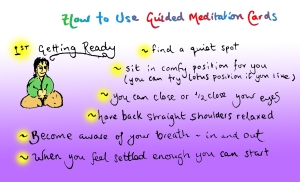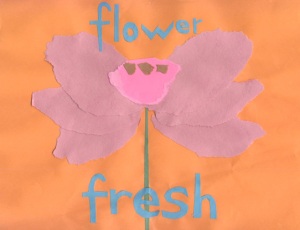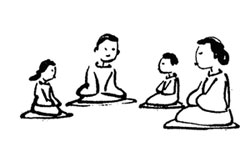From Mindfulness Bell Issue #34
Note: What you might say is in boldface. The answers to questions in parenthesis are the answers our children gave us. You might need to reword the questions to get similar answers.
Here is what each child will need to do this experiment:
2 clear wide mouth jars or clear plastic cups (or cut off the top 1/4 of a clear plastic water bottle)
2 paper towels
Soil
8 lima or pinto beans
You’ll also need:
1 permanent marker
We’re going to plant some bean seeds.
Note: Demonstrate and help the children as you give them the following directions:
Wrap the inside of one of your cups with a paper towel.
Carefully put soil inside the cup, behind the paper towel. Fill it about 3/4 full.
Place 4 beans between the paper towel and the side of the cup. Make a lot of space between the beans. Like us, beans like freedom!
Please do the same with the other cup.
Note: We use clear cups and paper towels so that children can watch as the beans grow roots and stems.
Let’s name your bean seeds. One cup will be the home for your Happiness Beans; you will name your beans after ways that make you truly happy. For example, does it make you happy when others smile at you? Does it make you happy when you smile at others? If so, you might like to name one of your beans “Smile”! Other names for your Happiness Beans might be mindfulness, generosity, freedom, safety, love, hope, sharing.
What makes you truly happy? (playing with my dog, being with my friends, sharing, irises)
With the permanent marker write the names of your beans on your cup.
Your other cup will be the home for your Unhappiness Beans; you will name your beans after ways that do not make you happy. For example, does it make you unhappy when you or someone you know is angry? If anger makes you unhappy, you might like to name one of your beans, “Anger.” Other names for the Unhappiness Beans might be stinginess, fear, sadness, impatience, hurrying, jealousy.
What makes you unhappy? (fights, war, stealing, not sharing)
With our permanent marker write the names of your beans on your cup.
Discussion:
These beans are seeds. If the causes and conditions are right, they will grow into bean plants.
What causes and conditions do you think need to happen to make the bean seeds grow into bean plants? (Soil, air, light and water.)
You have Happiness and Unhappiness bean seeds. Which bean seeds do you want to grow? (Only the Happiness seeds)
How can you help the Happiness bean seeds grow? (Give them what they need: soil, air, water and light.) How can you keep the Unhappiness bean seeds from growing? (Do not give them soil, air, water and/or light.)
Help the children water their Happiness Beans. They should not water the Unhappiness Beans.
We people have things like seeds inside us, just like your bean cups. We all have the seeds of smiling, mindfulness, generosity, freedom, safety, love, playing and sharing (and lots of other happy seeds!) inside of us.
Note: Be sure to name the ways to be happy which children offered earlier.
We all also have the seeds of anger, stinginess, fear, impatience, hurrying, fighting, stealing, not sharing and jealousy (and lots of other unhappy seeds!) inside of us.
Note: Be sure to name the “unhappy seeds ” which children offered earlier.
When the causes and conditions are right, our “seeds” grow, too.
Just like with our bean seeds, if we give our happy seeds soil, air, light and water, they will grow. Of course, if we give the unhappy seeds in us the things they need, they will grow, too!
Just like with our bean seeds, we are the ones who get to decide which seeds will grow and which will not grow inside us.
What does it mean to give the seeds inside us air? (freedom, space, time)
What does it mean to give the seeds inside us light? (to notice our seeds; to shine the light on them.)
What are some ways we can water (and not water!) the seeds inside ourselves?
Note: With some guidance, these are some ways our children thought of to water/not water the seeds of happiness and unhappiness in ourselves:
Practice: “One way to water the seed of smiling is to smile a lot.”
Awareness: “I water the seed of generosity when I notice that I am being generous.”
Don’t concentrate: “One way to not water the seed of anger is to notice it but to not keep concentrating on it.”
Check my perceptions: “I can ask, ‘Am I sure?’ when I start to get jealous of a friend. Am I sure what my friend has is what I want?”
Act nice: “One way to water the seed of love is to tell our friends that we love them.”
Say a Gatha: “One way to water the seed of appreciation is to say the food Contemplations gatha.”
Breathe in and out: “One way to not water the seed of fear is to pay attention to our breathing.”
Don’t watch mean TV shows or videos or listen to mean songs on the radio: “One way to not water the seed of meanness is to watch only shows that are friendly and kind.”
Understand: “When I start to get irritated at my dad or mom, I can try to understand why they did the thing that made me irritated.”
Take 3 Steps: “One way to not water the seed of sadness is to take Three Steps. 1. Enjoy things that make me happy. 2. Notice when I am sad. 3. Later, when I am not sad anymore, think about what had made me sad and try to understand it and change it.”
Invite the children to take their happiness and unhappiness seeds home to care for.
(Two sources for grown-ups: Transformation at the Base and The Heart of the Buddha’s Teaching, both by Thich Nhat Hanh)
Submitted by Terry Cortes-Vega
Filed under: Activities you can try, Nature Awareness | Tagged: beans, causes and conditions, children, grow, happy seeds, kids, mindfulness, seeds, unhappy seeds, watering | Leave a comment »








You must be logged in to post a comment.